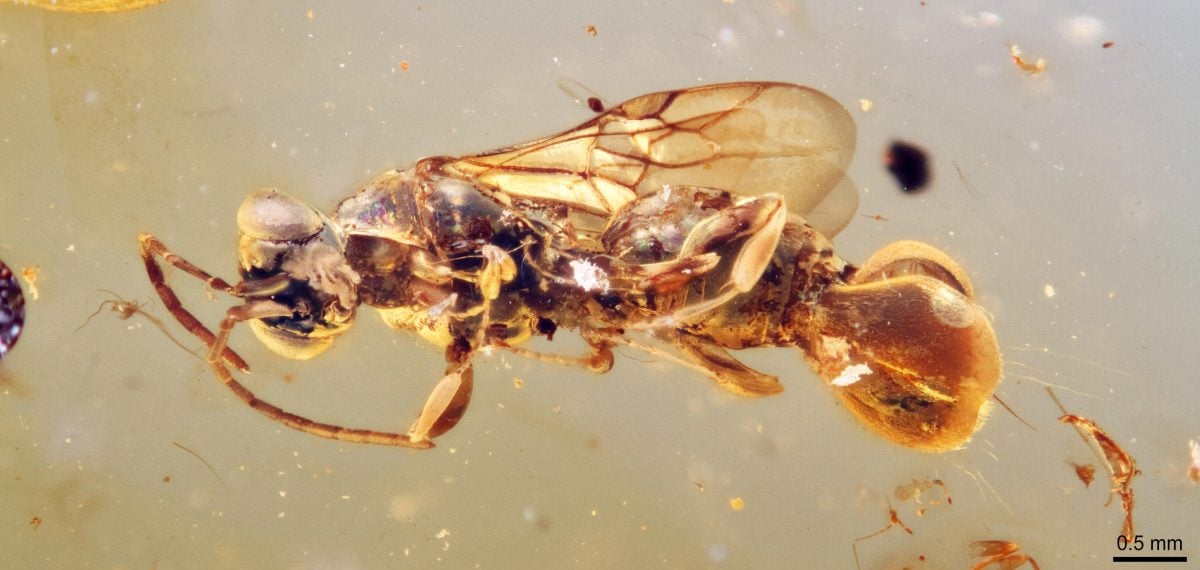In a discovery straight out of a sci-fi horror movie, scientists have unearthed a bizarre and terrifying new species of wasp trapped in amber for 99 million years. With features that seem almost alien in design, this ancient predator offers a chilling glimpse into the dark side of prehistoric life — a real-life monster from the age of dinosaurs.
This strange wasp, recently analyzed by entomologists and paleontologists, is unlike anything alive today. Its unique anatomy, evolutionary adaptations, and the era it lived in make it one of the most fascinating fossil insect discoveries in recent years.
Trapped in Time: A 99-Million-Year-Old Amber Prison
The wasp was discovered preserved in Burmese amber (from modern-day Myanmar), which has become one of the richest sources of well-preserved Cretaceous-era life. The amber dates back to about 99 million years ago, during the height of the Cretaceous Period, when dinosaurs roamed the Earth and flowering plants were just beginning to flourish.
Thanks to the perfect preservation properties of amber, scientists could study the wasp’s body in incredible detail — from its jaws to its wings and strange, spine-covered body.
Meet Caputoraptor elegans — The Cretaceous Monster Wasp
Named Caputoraptor elegans, this newly identified wasp is part of an extinct group of parasitic wasps. While the name “elegans” might sound elegant, its appearance was anything but.
Key Features of the Ancient Wasp:
Massive, claw-like jaws: Far larger than those of modern wasps, suggesting it had a brutal method of capturing or holding prey.
Elongated neck: Giving it a striking appearance, almost snake-like, for added maneuverability.
Hooked legs and spines: Ideal for clinging onto hosts or prey.
Bulging, complex eyes: Suggesting it had excellent vision — likely an aerial predator or parasite that needed precision.
Its alien-like structure suggests it was highly specialized, possibly targeting other insects or larvae as hosts for its young — a behavior common in parasitic wasps today.
Why This Discovery Is So Important
While the world has over 100,000 species of wasps today, ancient parasitic wasps are incredibly rare in the fossil record. The discovery of Caputoraptor elegans opens up exciting new possibilities in understanding the evolution of parasitism, predator-prey relationships, and biodiversity during the Cretaceous period.
1. Evolutionary Insight
This wasp reveals a stage in evolution where insects were rapidly diversifying alongside flowering plants and early mammals. It may represent a transitional species, bridging ancient forms with modern parasitoids.
2. Amber Fossils Tell Untold Stories
Amber is nature’s time capsule. It preserves not only the body of insects but also, in some cases, behavior, like predation, mating, or even parasitism in action. With the discovery of this wasp, we gain insight into the ecology of a prehistoric forest — complete with predators, prey, and parasitic interactions.
3. Unseen Complexity in Prehistoric Ecosystems
Findings like these show how complex insect ecosystems were, even 100 million years ago. This creature wasn’t just a bug—it was part of a web of life that influenced the evolution of other species.
A Monster to Its Prey: Was It a Parasite or a Predator?
Though small by our standards (measuring just a few millimeters), this wasp was likely a nightmare to its prey. Scientists believe it may have functioned similarly to today’s parasitoid wasps — insects that lay their eggs inside or on a host organism, allowing the larvae to slowly consume the host from the inside out.
Its massive jaws might have helped it hold struggling prey or cut into plant material to reach hidden hosts. Some theories suggest it may have hunted insect larvae hiding in tree bark or leaves.
How Did Scientists Study It?
Using cutting-edge imaging techniques like micro-CT scanning, scientists could look inside the amber without damaging it. This allowed for a full 3D reconstruction of the insect’s body and internal features.
The detailed analysis revealed:
Unique mouthparts not seen in any living wasp
Wing vein patterns indicating it belonged to a now-extinct family
Spines and sensory hairs adapted for precision hunting
The Era of Dinosaurs and Deadly Insects
When Caputoraptor elegans was alive, Earth looked very different. The continents were still drifting into their current shapes, and the climate was warmer and wetter. The skies were filled not just with flying reptiles like pterosaurs, but also with a booming population of insects.
This wasp likely lived in a dense tropical forest, buzzing alongside early bees, dragonflies, and other predatory insects. It may have even coexisted with small feathered dinosaurs or early birds — making it part of a thriving prehistoric ecosystem.
The Bigger Picture: What Prehistoric Insects Teach Us
Insects are often overlooked in discussions about prehistoric life, which tend to focus on dinosaurs or marine reptiles. But in reality, insects have been around for over 400 million years, and they have evolved into countless forms.
Fossils like this ancient wasp help scientists understand:
How insect evolution kept pace with flowering plants
The origin of parasitic behaviors
The changing dynamics of ecosystems through deep time
Could Creatures Like This Exist Today?
Although Caputoraptor elegans is long extinct, its bizarre design reminds us that nature is full of strange surprises. Some modern wasps, like the tarantula hawk or the jewel wasp, still display terrifying parasitic behaviors. They don’t look quite as alien, but they’re just as efficient — and deadly — in their own way.
Conclusion: A Real-Life Monster from the Cretaceous Forest
The discovery of Caputoraptor elegans, a strange wasp preserved in amber for 99 million years, offers a rare and chilling glimpse into the darker side of evolution. With its terrifying jaws, alien-like body, and likely parasitic lifestyle, this tiny creature was a real-life monster in its own time.
As scientists continue to study amber fossils, we can expect more such revelations — stories of survival, predation, and adaptation that unfolded long before humans ever walked the Earth.
This find is a reminder that sometimes, the most terrifying monsters aren’t the biggest — they’re the smallest, and they’ve been around for millions of years.

















+ There are no comments
Add yours